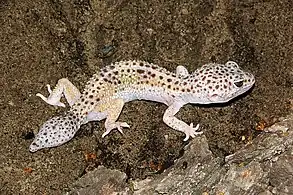Eublepharis
The genus Eublepharis, of which one known type is The Leopard Gecko, were first described by the British zoologist John Edward Gray in 1827. The etymology of their name is 'eu' = good (=true) |'blephar' = eyelid, and all have fully functional eyelids. Members of this genus are found in eastern and southwestern Asia where they reside in rocky grassland habitats. These geckos are sturdily built. Their tail is shorter than their snout–vent length and their body is covered with numerous wart-like bumps. The toes do not have adhesive lamellae or membranes (Eublepharis cannot climb like their other gecko cousins). Eublepharis are crepuscular or nocturnal ground-dwellers. Included in this group is the popular pet gecko: the leopard gecko. It is especially popular in the United States, where there are nearly 3 million captive bred leopard geckos. A common misconception about leopard geckos is that they live in dry, arid deserts, but they are from rocky grasslands in southwestern Asia, including northern India, Afghanistan and Pakistan. They avoid deserts and places with low water and prefer areas of low sunlight.
| Eublepharis | |
|---|---|
 | |
| Common leopard gecko (Eublepharis macularius) | |
| Scientific classification | |
| Kingdom: | Animalia |
| Phylum: | Chordata |
| Class: | Reptilia |
| Order: | Squamata |
| Family: | Eublepharidae |
| Genus: | Eublepharis Gray, 1827 |
| Species | |
|
Eublepharis angramainyu | |
Anatomy
Leopard geckos hatch at a length of 6.5 to 8.5 cm (2.6 to 3.3 inches) and weighing approximately 3 grams. An adult of this species can reach a length of 20.5 to 27.5 cm (8.1 to 11 inches) and a weight of 54-65 grams.
Leopard geckos have tough skin around their back, neck and head, well suited to move on rocky terrain in a dry environment. Like all reptiles, they shed this skin periodically to allow for further growth.[1] Unlike many other reptiles, the leopard gecko's shed skin is often not viewable, as leopard geckos often shed in private and eat the skin once it has been shed.
Diet
Leopard geckos only eat insects. Crickets, mealworms, waxworms, etc.[2]
Species of the genus Eublepharis
| Image | Scientific name | Common Name | Distribution |
|---|---|---|---|
 | Eublepharis angramainyu | Iraqi eyelid gecko | Iraq, Iran, Turkey and Syria. |
 | Eublepharis fuscus | West Indian leopard gecko | western India, with its range possibly extending to southeastern Pakistan |
 | Eublepharis hardwickii | East Indian leopard gecko | India and Bangladesh. |
 | Eublepharis macularius | Common leopard gecko | Afghanistan, Iran, Pakistan, India, and Nepal. |
 | Eublepharis satpuraensis | Satpura leopard gecko | central Indian states of Madhya Pradesh, Maharashtra and Chhattisgarh |
 | Eublepharis turcmenicus | Turkmenistan eyelid gecko | Turkmenistan and northern Iran. |
The members of the Goniurosaurus kuroiwae superspecies were formerly considered members of the genus Eublepharis.
Eublepharis key identifiers
Habitats
Eublepharis can be found throughout Afghanistan, Iraq, Iran, Northwest India, and Pakistan.[3] They prefer dry, semi-dry, and more arid grassland regions.
References
- "Shedding - Leopard Gecko Wiki". leopardgeckowiki.com. Retrieved 2019-03-05.
- "Leopard Geckos Food and Diet". www.leopardgecko.co.uk. Retrieved 2019-03-05.
- "Eublepharis macularius (Common Leopard Gecko)". Animal Diversity Web. Retrieved 2018-10-24.